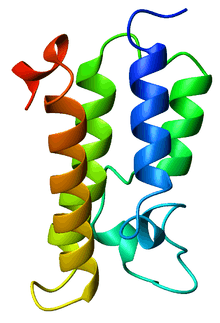Bromodomain
| Bromodomain | |||||||||
|---|---|---|---|---|---|---|---|---|---|
 Ribbon diagram of the GCN5 bromodomain from Saccharomyces cerevisiae, colored from blue (N-terminus) to red (C-terminus).[1] | |||||||||
| Identifiers | |||||||||
| Symbol | Bromodomain | ||||||||
| Pfam | PF00439 | ||||||||
| InterPro | IPR001487 | ||||||||
| SMART | SM00297 | ||||||||
| PROSITE | PDOC00550 | ||||||||
| SCOP | 1b91 | ||||||||
| SUPERFAMILY | 1b91 | ||||||||
| CDD | cd04369 | ||||||||
| |||||||||
A bromodomain is an approximately 110 amino acid protein domain that recognizes monoacetylated lysine residues such as those on the N-terminal tails of histones. Their affinity is higher for regions where multiple acetylation sites exist in proximity. This recognition is often a prerequisite for protein-histone association and chromatin remodeling. The domain itself adopts an all-α protein fold, a bundle of four alpha helices each separated by loop regions of variable lengths that form a hydrophobic pocket that recognizes the acetyl lysine.[1][2]
Discovery
The bromodomain was identified as a novel structural motif by John W. Tamkun and colleagues studying the brm gene, and showed sequence similarity to genes involved in transcriptional activation.[3]
Examples
In humans there are 46 sets of chromatins that contain a total of 61 bromodomains. A well-known example of a bromodomain family is the BET (Bromodomain and extraterminal domain family). Members of this family include BRD2, BRD3, BRD4 and BRDT. However proteins such as ASH1L also contain a bromodomain. Dysfunction of BRD proteins has been linked to diseases such as human squamous cell carcinoma and other forms of cancer.[4]
Small molecule inhibition
Members of the BET family have been implicated as targets in human cancer. These BET inhibitors have shown therapeutic effects in multiple preclinical models of cancer and are currently in clinical trials in the United States.[5]
Small molecule inhibitors of non-BET bromodomain proteins BRD7 and BRD9 have also been developed.[6][7]
See also
References
- ↑ 1.0 1.1 PDB 1e6i; Owen DJ, Ornaghi P, Yang JC, Lowe N, Evans PR, Ballario P, Neuhaus D, Filetici P, Travers AA (November 2000). "The structural basis for the recognition of acetylated histone H4 by the bromodomain of histone acetyltransferase gcn5p". EMBO J. 19 (22): 6141–9. doi:10.1093/emboj/19.22.6141. PMC 305837. PMID 11080160.
- ↑ Zeng L, Zhou MM (February 2002). "Bromodomain: an acetyl-lysine binding domain". FEBS Lett. 513 (1): 124–8. doi:10.1016/S0014-5793(01)03309-9. PMID 11911891.
- ↑ Tamkun JW, Deuring R, Scott MP, Kissinger M, Pattatucci AM, Kaufman TC, Kennison JA (February 1992). "brahma: a regulator of Drosophila homeotic genes structurally related to the yeast transcriptional activator SNF2/SWI2". Cell 68 (3): 561–72. doi:10.1016/0092-8674(92)90191-E. PMID 1346755.
- ↑ Filippakopoulos, Panagis (2012). "Histone Recognition and Large-Scale Structural Analysis of the Human Bromodomain Family". Cell 149 (1): 214–231. doi:10.1016/j.cell.2012.02.013.
- ↑ Shi, Junwei (2014). "The Mechanisms behind the Therapeutic Activity of BET Bromodomain Inhibition". Molecular Cell 54 (5): 728–736. doi:10.1016/j.molcel.2014.05.016.
- ↑ PMID 25864491 (PubMed)
Citation will be completed automatically in a few minutes. Jump the queue or expand by hand - ↑ PMID 25856009 (PubMed)
Citation will be completed automatically in a few minutes. Jump the queue or expand by hand